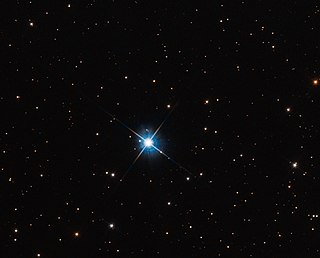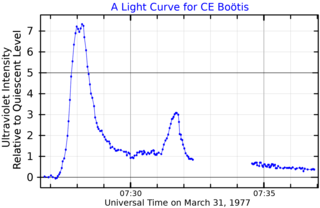
Gliese 570 is a quaternary star system approximately 19 light-years away. The primary star is an orange dwarf star. The other secondary stars are themselves a binary system, two red dwarfs that orbit the primary star. A brown dwarf has been confirmed to be orbiting in the system. In 1998, an extrasolar planet was thought to orbit the primary star, but it was discounted in 2000.
HD 168443 is an ordinary yellow-hued star in the Serpens Cauda segment of the equatorial constellation of Serpens. It is known to have two substellar companions. With an apparent visual magnitude of 6.92, the star lies just below the nominal lower brightness limit of visibility to the normal human eye. This system is located at a distance of 127 light years from the Sun based on parallax, but is drifting closer with a radial velocity of −48.7 km/s.

Gliese 229 is a binary system composed of a red dwarf and the second brown dwarf seen by astronomers, 18.8 light years away in the constellation Lepus. The primary component has 58% of the mass of the Sun, 69% of the Sun's radius, and a very low projected rotation velocity of 1 km/s at the stellar equator.
Gliese 674(GJ 674) is a small red dwarf star with an exoplanetary companion in the southern constellation of Ara. It is too faint to be visible to the naked eye, having an apparent visual magnitude of 9.38 and an absolute magnitude of 11.09. The system is located at a distance of 14.8 light-years from the Sun based on parallax measurements, but is drifting closer with a radial velocity of −2.9 km/s. It is a candidate member of the 200 million year old Castor stream of co-moving stars.
HD 28185 is a yellow dwarf star similar to the Sun located 128 light-years away from Earth in the constellation Eridanus. The designation HD 28185 refers to its entry in the Henry Draper catalogue. The star is known to possess one long-period extrasolar planet.
Pi Mensae, also known as HD 39091, is a yellow dwarf star in the constellation of Mensa. This star has a high proper motion. The apparent magnitude is 5.67, which can be visible to the naked eye in exceptionally dark, clear skies. It is nearly 60 light-years away. The star is slightly larger than the Sun in terms of mass, size, luminosity, temperature and metallicity, and is about 730 million years younger. It hosts three known planets.
Gliese 849, or GJ 849, is a small, solitary star in the equatorial constellation of Aquarius. It has a reddish hue and is invisible to the naked eye with an apparent visual magnitude of 10.41. The distance to this star is 28.8 light-years based on parallax, but it is drifting closer to the Sun with a radial velocity of −15.3 km/s. It has a pair of confirmed gas giant companions.

Gliese 440, also known as LP 145-141 or LAWD 37, is an isolated white dwarf located 15.1 light-years from the Solar System in the constellation Musca. It is the fourth closest known white dwarf to the Sun
Gliese 86 is a K-type main-sequence star approximately 35 light-years away in the constellation of Eridanus. It has been confirmed that a white dwarf orbits the primary star. In 1998 the European Southern Observatory announced that an extrasolar planet was orbiting the star.
HD 115404 is a binary star system located in the constellation Coma Berenices. Parallax measurements made by Hipparcos put the system at 36 light-years, or 11 parsecs, away. The combined apparent magnitude of the system is 6.52, with the magnitudes of the components being 6.66 and 9.50.
36 Ursae Majoris is a double star in the northern constellation of Ursa Major. With an apparent visual magnitude of 4.8, it can be seen with the naked eye in suitable dark skies. Based upon parallax measurements, this binary lies at a distance of 42 light-years from Earth.
Gliese 806 is a star in the northern constellation of Cygnus, located about a degree to the southeast of the bright star Deneb. It is invisible to the naked eye with an apparent visual magnitude of +10.79. The star is located at a distance of 39.3 light years from the Sun based on stellar parallax. It is drifting closer with a radial velocity of −24.6 km/s, and is predicted to come to within 30.1 light-years in ~198,600 years. The star hosts two known planetary companions.
Gliese 521 is a double star in the northern constellation of Canes Venatici. The system is located at a distance of 43.6 light-years from the Sun based on parallax measurements, but is drawing closer with a radial velocity of −65.6 km/s. It is predicted to come as close as 15.70 light-years from the Sun in 176,900 years. This star is too faint to be visible to the naked eye, having an apparent visual magnitude of +10.26 and an absolute magnitude of 10.24.
Gliese 163 is a faint red dwarf star with multiple exoplanetary companions in the southern constellation of Dorado. Other stellar catalog names for it include HIP 19394 and LHS 188. It is too faint to be visible to the naked eye, having an apparent visual magnitude of 11.79 and an absolute magnitude of 10.91. This system is located at a distance of 49.4 light-years from the Sun based on parallax measurements. Judging by its space velocity components, it is most likely a thick disk star.
Gliese 880 is a red dwarf star in the northern constellation of Pegasus that may host an exoplanetary companion. No stellar companions to Gliese 880 have been discovered as of 2020.
Gliese 328, also known as BD+02 2098, is a M-type main-sequence star located 66.9 light-years away in the constellation Hydra. Its surface temperature is 3989 K. Gliese 328 is depleted in heavy elements compared to the Sun, with a metallicity Fe/H index of −0.13. The age of the star is unknown. Gliese 328 exhibits an activity cycle similar to that of the Sun, with a period around 2000 d.

Gliese 569 is a ternary star system composed of a main-sequence star orbited by a pair of brown dwarfs in the constellation of Boötes about 32 light years away.
Gliese 514, also known as BD+11 2576 or HIP 65859, is a M-type main-sequence star, in the constellation Virgo 24.85 light-years away from the Sun. The proximity of Gliese 514 to the Sun was known exactly since 1988.




